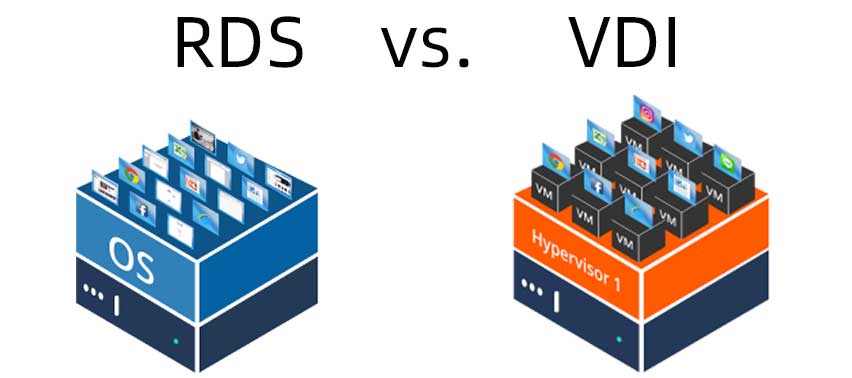
Companies aspire for technologies that can be efficient and cost-effective to boost their productivity and meet their present and future requirements. Desktop virtualization is a top trending term, which is capable of delivering high performance, high security and required flexibility to all businesses. Either Remote Desktop Services (RDS) or Virtual Desktop Infrastructure (VDI) can achieve desktop virtualization. Both have some similarities and differences, strengths and weaknesses, which we are going to discuss.
Remote Desktop Services – Remote Desktop Services, formerly known as Terminal Services, allows multiple users to remotely connect to a Virtual Machine(VM) or Operating System(OS). In RDS, users connect to a remote desktop session, share the operating system, applications and hardware resources of the host, and so it is termed shared computing. Applications and data are centralized making end-user control, software installation, configuring and updates easier.
Advantages of RDS:
Simplicity: RDS infrastructure is simple to set up as it has fewer components. Users utilize shared resources running on a shared OS instance which facilitates a workstation provisioning in just seconds.
Low costs: RDS minimizes licensing costs, as it is low for clients than the server OS and application costs. Because users are sharing a single system, RDS deployments are less resource-hungry so investment in hardware resources(CPU, memory, and storage) is not high. For instance, with vCloudPoint’s RDS solution, you can consolidate up to 99 sessions with a solid performance on a single server or even a high-end consumer PC.
Easy maintenance: RDS has less moving parts, it takes much less time and effort to maintain RDS deployments. Managing the RDS deployment is also easy that no typical training is required for the IT admin.
Drawbacks of RDS:
Personalization: desktop personalization and application customization are limited because all the users access the same OS and applications during their desktop sessions.
Resources contention: the users’ sharing the hardware and software resources of the server can lead to contention and performance issues.
Compatibility: some applications are not designed for session-based access by multiple users.
Virtual Desktop Infrastructure – Virtual Desktop Infrastructure (VDI) is to run user desktops inside virtual machines, hosted on a server computer. The server computer hosting the virtual desktops uses the hypervisor to abstract the physical compute and storage resources and make them available to the individual VMs that support the desktops.
Advantages of VDI:
Resources allocation: VDI gives the ability for IT pros to tailor resource availability to different users based on their needs. Users that work with graphics editing software require more resources for their desktops compared to users who only run basic word processing and web browsing applications.
User Isolation: Persistent desktops of VDI allow users for personalization and, if IT pros approve, can even have custom application installs and OS configurations. In VDI, every user has access to an allotted VM running a separate OS, avoiding the contention issues with RDS deployments.
Application Compatibility: VDI has no compatibility issues because each user is allotted a dedicated VM that runs a separate operating system.
Snapshot technology: snapshot technology in VDI is beneficial; the users can roll back to the previous event when virus or malware corrupts the OS.
Drawbacks of VDI:
Complexity: VDI structure is not simple and setting up is difficult too. Very high skill levels for IT staff are typically required for deployment and maintenance. IT staff managing multiple OS instances, patching and updating them is strenuous.
High Costs: VDI is considered expensive. The high overhead cost comes from the additional hardware resources, licenses for multiple VDI software offerings, and Windows OSs per user and Virtual Desktop Access (VDA) on a year-subscription basis.
RDS and VDI – Which one to choose?
In general, RDS is a better fit for organizations with many users who require the same applications and amount of resources. RDS is simpler to implement and maintain than VDI while sacrificing a bit of customization. Multiple users sharing server resources minimizes storage and overhead costs but lead to contention and application issues. VDI is a better option for more complex deployments with different user types, and deliver the virtual desktops and applications separately to avoid any compatibility issues. However, one has to consider the high cost and complexity in deployment and maintenance.